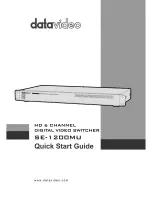
Models 707B and 708B Switching Matrix Reference Manual
Section 3: Functions and features
707B-901-01 Rev. A / August 2010
3-9
•
(on page 7-156)
•
(on page 7-157)
•
Scanning examples
Assume you have a 7072 card installed in slot 1 of your instrument and you want to scan column 5 on
rows 1 to 3. To create this scan, send the following command:
scan.create("1A05, 1B05, 1C05")
To see the scan list generated from this command, send:
print(scan.list())
The following will be output:
Init) OPEN...
1) STEP: 1A05
CLOSE: 1A05
2) STEP: 1B05
OPEN: 1A05
CLOSE: 1B05
3) STEP: 1C05
OPEN: 1B05
CLOSE: 1C05
This indicates that the scan list includes three steps. For step 1, the running scan will close "1A05".
For step 2, it opens "1A05" and closes "1B05". For step 3, it will open "1B05" and close "1C05".
The following table illustrates how scan count works with this scan list to determine total number of
channel closures during a scan.
How scan count works with the scan list
Number of steps
Scan count value
Total number of step channel closures
3
1 (default)
3 (each step channel once – 1A05, 1B05, 1C05)
3 2
6 (each step channel twice – 1A05, 1B05, 1C05, then
1A05, 1B05, 1C05)
3 3
9 (each step channel three times – 1A05, 1B05,
1C05 then 1A05, 1B05, 1C05 then 1A05, 1B05,
1C05)
scan.stepcount
scan.scancount
scan.stepcount X scan.scancount
Therefore, scan count represents how many times to loop on the total number of steps in a defined
scan list.
If you want to pace the steps of closing and opening channels by detecting a trigger on digio trigger
line 3, the following flow chart indicates the sequence of events to achieve this. This example uses
the same scan list as above and uses a scan count of 3.
As the flow chart below shows, to transition between start of scan to step 1, step 1 and step 2, step 2
and step 3, a trigger needs to be detected on digio trigger line 3. At the end of step 3, if the scan
count has reached three, the scan completes. If the scan count hasn't reached 3 then, loop back
around to repeat steps 1 to 3 again.
















































